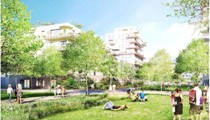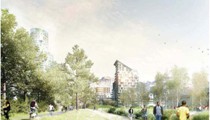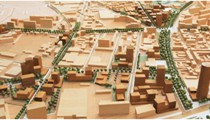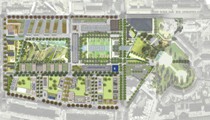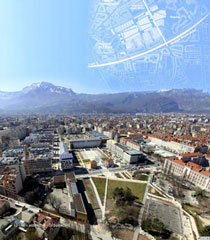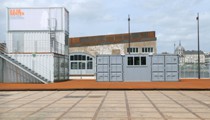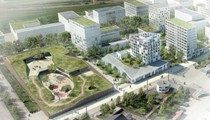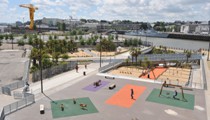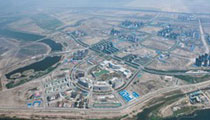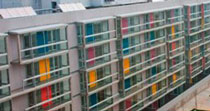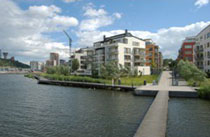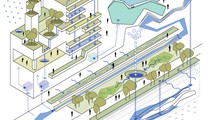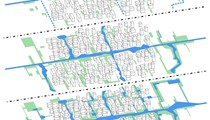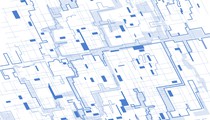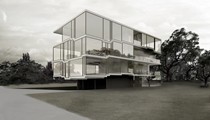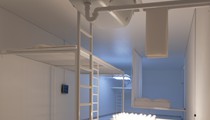

Beyond the technologies of sustainability. Alberto Clementi |
 |
We have often said that sustainable development cannot be reached exclusively through increasingly sophisticated technological advances, or engineering and organisational solutions. It must be understood as a value to be built up socially, with individuals, societies and their institutions, first by giving them the means and then by their accepting the responsibilities. Even more comprehensively, it is a way of thinking and of acting “suited to collectively imagining the world of tomorrow. It is a movement of ideas, comparable to 18th century enlightenment, to which anyone could sign on,” thus Bidou has defined it in his recent book “Le Dévelopment Durable. Intelligence du XXI siècle”, reviewed by Angrilli in this issue of EcoWebTown.
This wider meaning of sustainability invites a reformulation of the variety of urban plan and project strategies, including for example the management of urban wastes, a sector which has generally been overlooked by traditional city planning. One must not think that the waste issue can be solved by simply perfecting technology or the organisational processes of the agency carrying out the service. Such a complex problem requires a new social perception of the relationship between individuals and the environment in which they live, a concept of citizenship inspired by a will to reduce waste, restore value to what is held in common, treat public property with care and participate actively in the fight against climate change. It is where waste management is organised on the basis of Paul Connett’s four virtuous R’s (Reduce, Reuse, Recover energy and Recycle).
The contribution of city planning to this new culture can be relevant: by selecting the most suitable sites, by contributing to identifying the most appropriate collection and management models for the area, ascertaining environmental compatibility, ....read more
From eco districts to creative towns. Dominique Bidou |
 en en |
 fr fr |
There is more to creating a town than simply juxtaposing houses, just like as a set of HQE constructions alone does not make a high-environmental quality neighbourhood. It takes more than the creation of an eco-district to make a town ecological.
Ecology is the science of systems, cycles, interdependencies and complementarities. This science fully applies to towns beyond fauna and flora, habitats and material flows. The concepts of environmental richness and productivity offer new meaning to a town's development. Today we are experiencing a historical era for humanity, where the time of the finite world begins, to quote Paul Valéry. The simplicity that infinite expansion offered is no longer admissible, and will be made increasingly costly in all respects, in terms of both finance and resources. Tomorrow's growth will be different from what we have seen until now; it will be founded on the intensification of resource usage, and not on the systematic search for new resources: intensification instead of expansion. This transformation applies to towns, and gives new direction to the planning and installations of the future.
The planning of public spaces reflects this logic. Offering links between the different living spaces, they ensure mobility and landscape, rainwater management, recreation for all ages, spaces for meeting up and social activities, sites of trade and commerce and the welcoming of numerous ground, air and underground networks. Many functions need to be combined in order to obtain an "intense" town. Each new element, whether house, equipment, garden or district, needs to accentuate the town's intensity, a measure of its sustainability, both in the original sense of the term and in the sense of its development.
Where towns cannot be rapidly made entirely sustainable, it must be possible to renovate districts or create urban expansion in accordance with sustainable-development rules. It was this hypothesis that gave rise to several districts combining every environmental and social quality imaginable, elsewhere in Europe to begin with and more recently in France. They can be found in London (Bedzed), ....read more
Ecodistrict : a sustainable and desirable urban project? Or, how to avoid being led by technical solutions. Michel Sabard |
 en en |
 fr fr |
The difficulties of city life are detailed in the Green Book published in 1990 by the European Community and further described in a sustainable cities statement published in 1996. Twelve years later, in France and Europe, the Ecodistrict concept brings together all the possible improvements which can create a more ideal way of city living. This vision arises from the recent culture of sustainability aiming to preserve both humanity and the planet.
Pierre Lefèvre and I, both teaching at the architecture school of Paris la Villette, have tried to give a definition inspired by the examples that we have visited in Europe at the end of the 90s.
An Ecodistrict is:
- a part of a city, not distinct from its overall sustainability plan (mix of population, transportation, density…);
- qualified by a new type of long term, interdependent and locally-based development, aiming to create a socially mixed population with equal access to housing, social services, local economy etc;
- where inhabitants can live, work and travel together; where both public and private spaces are attractive; where risks to health are minimised;
- a response to the environmental issues affecting the planet (climate change and inefficient energy use, loss of biodiversity and destruction of nature) through energy saving, public transport, pollution and waste management…
The Ecodistricts : a major Grenelle initiative
On October 22 2008, just after the publication of the Grenelle action plan, Jean-Louis Borloo announced the launch of the Sustainable City Plan, part of which is the call for eco-districts projects. This programme aims to foster a new way of designing, of building, expanding and managing a .....read more
French sustainable neighborhoods: careful projects regarding the environment but often with a quite problematic urban design. Michel Bonetti |
 |
This paper presents the results of an assessment we have recently carried out on six so-called sustainable neighborhoods recently built in France in various major towns such as Nancy, Nantes, Rennes, Bordeaux…etc. These neighborhoods are quite large, since each of them gathers from 1.000 to 2.000 dwellings, and sometimes more.
This evaluation was focused on the urban and architectural design quality regarding the urban integration of these neighborhoods and the kind of social interactions and practices they may contribute to generate, as well as regarding the maintenance issues to which local authorities might be confronted to in the long term. As for any existing or newly built neighborhoods, these two topics have strong connections and are very important for sustainable neighborhoods future.
The architectural and urban design strongly influences the social life of residents.
In spite of the achievements and progress brought by some newly developed “sustainable neighborhoods” in France (such as low energy buildings, careful transportation connections…), we would like to draw attention to some major shortcomings which may await the local authorities and users of some of these districts. If not so, major problems may appear shortly with important difficulties, economic and social costs and urban management issues.
For instance, very large streets along which the facades of the buildings are flat and have narrow windows create a dull atmosphere which may even make inhabitants feel insecure and discourage them to stroll along. Another possible consequence is that people have few opportunities to meet other in this kind of urban environment. As we like to say, the design of a façade has social effects. The lack of green spaces and playgrounds may have the same effects. The estates maintenance difficulties (or the high cost of maintenance) often deriving of the complexity of urban lay out may also lead to a fast degradation of the estates, which is not acceptable for estates which are supposed to be “sustainable” , meaning in the first place that they are supposed to last in the long run. ....read more
« HQE for Urban Planning and Development »: an operational approach in the interests of Sustainable Planning. Adrien Ponrouch |
 en en |
 fr fr |
A logic of progress
It was inevitable that the High Environmental Quality (HQE, in French: Haute Qualité Environnementale, HQE) standard for buildings should encourage the creation of an HQE adapted to planning projects. Before the HQE Association had even begun working on the matter, operators used the "buildings" system to create economic activity zones or urban districts offering a variety of habitat and activity programmes.
In France, a 1976 law on nature protection made environmental impact studies obligatory, particularly for significant planning projects. Over the last 35 years, urban planners have had to incorporate environmental considerations into their projects, so now it is up to the construction sector to continue this good work. Unfortunately, this law often goes unheeded, both by the major projects it covers, without producing all the expected effects, and by minor projects, which are not required to adhere to it despite the fact that their ultimate cumulative impact is far from negligible.
Although it was not subject to these legal obligations, the construction industry, with significant support from certification organizations, voluntarily made enormous progress in terms of the HQE approach in the course of the 1990s and 2000s. Paradoxically, it is more advanced today than urban planning when it comes to tools recognizing its efforts towards sustainable development. A major part of the progress made has therefore come from the construction industry, i.e. at the level of complex but well-defined projects that affect a product, and the HQE approach is nowadays very much mastered by the actors involved at this level.
The HQE for Urban Planning and Development certification was created in 2002 as a result of the desire of both the HQE Association and planners to meet an evident need for harmonized methods. A "planning" equivalent to the Construction approach was needed. As the increased complexity of the issue at hand called for prudence, the HQE Association and its partners decided to build on the existing experience in the field. ...read more
|
Global metaphors, and techniques for sustainability. Fabrizio Paone |
 |
Such images as “ecowebtown” and “bio-logic city” set the reader in front of exhortations pushing inside near future, signed by the incoming of new specialized energetic, productive, distributive technologies.
In Italy, in Europe and in global sense, the growing dissatisfaction towards the urban environment, in relation to the growing spread of illegal and/or attitudes which are injurious towards human rights within cities, the rise of the population and its migration towards urban habits, the political intractability of the demographic subject, the influence on world policies made by energy’s and agriculture’s big corporations, the emerging environmental crisis sets already now political attitudes and represents a strong stimulus towards urban and economic renovation.
“Sustainability”, “ecology”, “intelligence”, “bio”, “logic” are terms investing the general sense of planning, and induce to return to the disproportion among its descriptive function, and real powers recognized to it by national states, having at their time difficulties to take part into settings which appear always more global, mobile and influenced by few international global players.
The attention given to the relevance of linguistic acts in the constitution of the technical knowledge is quite intermittent within urban interpretations, and brings back to some textes and research attitudes (in primis Attilio Belli (1995), “Immagini e linguaggio. Tracce per una ricerca” , CRU n.3; Bernardo Secchi (1984), Il racconto urbanistico. La politica della casa e del territorio in Italia, Einaudi, Turin, particularly the first two chapters and, about the metaphor, pp.57-60; George Lakoff, Mark Johnson (1980), Metaphores we live by, The University of Chicago Press, Chicago and London, italian translation (1982) Metafora e vita quotidiana, L’Espresso, Milan).
From a strict point of view the metaphor of the intelligent biologic device is transferred in the urban field from experimental medicine, where bio-computer marks a micro-chirurgical set of great suggestion, ....read more
|
New cities in the Far East. Dunia Mittner |
 |
Contemporary China and the Far East are interested today by intense phenomena of social, urban and territorial transformation and of promotion of several occasions of new cities’ construction, mostly cyber or eco, at the same time. Starting from the analysis of a certain number of study cases, this article aims at verifying the existence of common elements among new cyber and eco cities and their reference to achieved urban planning models.
New city represents a special observation’s angle in relation to the subject of modern and contemporary city, and more in particular in relation to some recent declensions turning attention towards most advanced technologies, ecological subjects and related to sustainability. New cities are not interesting so much in relation to their particular aspect given to them by being conceived altogether, but more because of the exploration of an urban dimension characterizing a much wider number of projects.
New cities’ foundation can be relevant in relation to several number of reasons, starting from the study of the policies of territorial organization advanced by certain States, engaged during the Twentieth century in the control of the consistency, number and life’s condition of the population, up to the questioning about the abridged version of the contemporary city.
It can be useful to ask oneself in which conditions the geopolitical and economical will to proceed towards programs of foundation develops. Within the European and Western context of the XX century, up to the Seventies, new cities’ construction has been related to several reasons, such as colonization from main European Nations towards Africa, new capital cities built after the creation of new nations or in relation to the necessity of redefining internal political geography, internal colonization within a country, industrial modernization, commerce and communication cities, technological and research centers and metropolitan growth control. During the Eighties and Nineties this last type of tool is adopted within countries of great economical growth, the so called «Asian tigers», ......read more
|
The hydropoietic city - water infrastructures for ecological city. Cesare Corfone |
 |
Intro
The “Hydropoietic city - water infrastructures for ecological city” research suggests new generation infrastructures designed to achieve water sustainability goals in urban contexts. Water infrastructures are conceived as ecological management tools for water resources – visible, localized and qualitative - but also as an opportunity to redefine the quality of urban landscape in both well-established cities and new building areas. The infrastructures configuration - plurimodal and multi-function-is coherent with the - underground or surface, natural or artificial, never-ending or seasonal, apparently static or in convulsive motion - hydrographic support. The present research starting point is the concept of the autopoietic orientation of the ecological city: the hydropoietic functioning tends to satisfy the water demand of the system in which it operates through the continuous reproduction of those factors that control water production and preservation. The “Hydropoietic city” view is based on the potential self-production capacity of water expressed in an enduring way of managing urban water cycle for local water utilities.Water infrastructures for ecological city (WIEC) have been proposed as new design categories whose main purpose is to give an answer to urban water management and ecological preservation demands. WIEC overall logic is that the improvement of the quality of the whole integrated urban water cycle.
Autopoietic orientation of the ecological city
Cities’ need for water supplies leads to a high exploitation system of natural resources and characterized by an increasing uptake of fresh water from natural water bodies and a return of low quality wastewater. The urban cycle of water conveyance and traditional disposal, ....read more
|
ADAPTIVE CITY |
 |
Climate change is a threat and, at the time, a new challenge for the CITY 'of the twenty-first century, projected in a scenario of evolution of contexts and of great uncertainty. Compared to this, the Government of the Territory, and the URBAN ARCHITECTURE are called to give new answers.
And 'now widely recognized by the international scientific community, and particularly by the Intergovernmental Panel on Climate Change (IPCC), that the cyclical changes in natural, historically found in the past few millennia, it is superimposed contributions, decisive and specific activities of human . Key role in the increase of temperature recorded in the distortion of the precipitation patterns, raise the level of the seas, and in the increased frequency and intensity of extreme events, which increase a number of risks at the local level, for territories and cities.
This new scenario, characterized by high uncertainty, undermines an apparatus of paradigms, now inadequate to provide useful responses to address risks which often cross the imaginable. The traditional town planning has ensured that human activities in the area were designed and sized with the assumption implicit or explicit, that the situation and the environmental conditions and land remain constant and not change over time. Theoretical assumptions, and the government of the territory, together with the obsolete mode of construction of the city, bring us a territory, especially in reference to our country, inert and inflexible, unprepared for changes, and unable to muffle the shots, even for the ' unauthorized building and the wicked, uncontrolled land consumption trend. A region highly vulnerable, when cities suffer impacts, often and unfortunately, disastrous.
Amidst this scenario, there is in fact the city, the place where you are performing main human activities and where the population is denser, ......read more
|
Interview with Philippe Rahm. Massimiliano Scuderi |
 |
MS: Philosopher Peter Sloterdijk defines the Globalized World as a closed, amniotic system. Following this, can we say that your approach focuses on sustainability?
PR : The building industry is one of the main culprits in global warming because the burning of fossil fuels to heat or cool dwellings is the source of nearly 50% of greenhouse gas emissions. Following some resistance and procrastination the whole industry is now mobilised in favour of sustainable development and arguing for improved heat insulation on outside walls, the use of renewable energies, consideration for the whole life cycle of materials and more compact building designs.
It is clear that these steps all have a definite objective, which is to combat global warming by reducing CO2 emissions. But over and above that goal, beyond such socially responsible and ecological objectives, might not climate be a new architectural language, a language for architecture rethought with meteorology in mind? Might it be possible to imagine climatic phenomena such as convection, conduction or evaporation for example as new tools for architectural composition? Could vapour, heat or light become the new bricks of contemporary construction?
Climate change is forcing us to rethink architecture radically, to shift our focus away from a purely visual and functional approach towards one that is more sensitive, more attentive to the invisible, climate-related aspects of space. Slipping from the solid to the void, from the visible to the invisible, from metric composition to thermal composition, architecture as meteorology opens up additional, more sensual, more variable dimensions in which limits fade away and solids evaporate. The task is no longer to build images and functions but to open up climates and interpretations. At the large scale, meteorological architecture explores the atmospheric ......read more
LIBRI / RIVISTE:
|
Le développement durable, l'intelligence du XXIe siècle (Dominique Bidou). Review of Massimo Angrilli |
 |
Dominique Bidou has a positive and attractive vision of sustainability. Far from that we encounter frequently, where the humanity is seen as moving toward a future of redemption and penitence. The vision expressed by Bidou in “Le développement durable, intelligence XXIe siècle” is built step by step as a new way of thinking, required to address the next stage in the life of humanity, the stabilization of population growth and the decrease of use of resources. A new model of development opposite to the quantitative growth, made by unconventional forms of progress, more diversified and mainly based on an inexhaustible resource: the human talent. In this book, sustainable development, or durable development, using the french term, is seen as an opportunity to be seized, an added value or, in the words of the author, an "extras" content. Far from the catastrophism that characterizes some of the actual thinkers, the book offers an attractive prospect, to be welcomed joyfully, that of a new world builded upon renewed principles and not on the repetition of past patterns. Humanity faces the stage of maturity, after an adolescence spent "wasting" resources of the planet: "A new era in which the future is built, decided, is forged on beliefs, values and desires, but also on the strict analysis of the situation, in a constant search for a form of permanent progress of our state...".
The design of a new society raises in Bidou an interesting comparison with the eighteenth century: a new Enlightenment, ...read more
- “Urbanpromo 2012 - Social Housing”, Turin, october 11 > 12, 2012
- “Urbanpromo 2012 Urban Regeneration”, Bologna, november 07 > 10, 2012
- "XXXIII Annual Scientific Conference AISRe", Rome, September 13 > 15, 2012
- "Architecture Biennal 2012 - Common Ground", Venice, August 29 > November 25, 2012
- “7ª Biennal Europea del Paisatge”, Barcellona, september 27 > 29, 2012
On line Magazine of Sustainable Design
SCUT, University Chieti-Pescara
ISSN 2039-2656
Registration Court of Pescara n° 9/2011 del 07/04/2011
Director : Alberto Clementi
Editorial staff:
Editor-in-chief: Massimo Angrilli
Valentina Carpitella, Aldo Casciana, Cesare Corfone, Michelangelo D'Ettorre
Claudia Di Girolamo, Michele Manigrasso, Massimiliano Scuderi, Edoardo Zanchini, Ester Zazzero
Segretariat: Claudia Di Girolamo
Translation: Tom Kruse
Web master: Luciano di Falco
Web graphic design: Luciano Di Falco, Laura Crognale, Dante Antonucci
Editorial board:
Giuseppe Barbieri (Pescara - IT), Attilio Belli (Napoli - IT), Dominique Bidou (FR), Lucina Caravaggi (Rome -IT), Maurizio Carta (Palermo - IT)
Francesc Munoz (Barcellona - ES), Josè Alfredo Ramirez (London - UK), Mosé Ricci (Genova - IT)
Manuel Gausa (Barcelona - ES), Renato Ricci (Ancona - IT), Pierluigi Sacco (Milan - IT)
Reporters:
Francesco Giacobone (Ministry of Infrastructure and Transport - IT), Dora Di Francesco (Ministry of Cultural Heritage anc Activities - IT)
Piergiorgio Ramundo (Republic of Cina - RC), Mario Tancredi (Colombia - CO)
Alona Martinez-Perez (Ireland-Scotland), Ivo Covic (Croatia - HR), Michel Sabard (France - FR), Jorg Schroder (Germany - DE)
Léa-Catherine Szacka (United Kingdom - UK), Irene Curulli, (Technical University Eindhoven - NL)
Rosaria Amantea (Greece -GR), Michele Cannatà (Portugal - PT), Pierpaolo Troiano (Spain - ES),Gunilla Kronvall (Sweden - SE)
Lucio Zazzara (Abruzzo - IT), Maria Mininni (Basilicata - Puglia - IT), Consuelo Nava (Calabria - IT), Michelangelo Russo (Campania - IT)
Filippo Boschi (Emilia Romagna - IT), Elena Marchegiani (Friuli-Venezia Giulia - IT), Cristina Imbroglini (Lazio - IT)
Rocco Corrado (Marche - IT), Luciano De Bonis (Molise - IT), Cristina Bianchetti (Piemonte-Val d’Aosta - IT), Cesarina Siddi (Sardegna - IT)
Cinzia Gandolfi (Toscana - IT), Pino Scaglione (Trentino-Alto Adige - IT), Maria Chiara Tosi (Veneto - IT)






